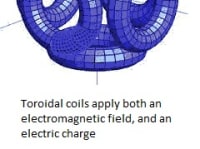The principles used in a polywell fusion reactor can also be applied, and more readily, for an electron-positron antimatter collider/reactor. Polywell fusion reactors make use of the principle that electrons require much smaller magnetic energy density in order to be magnetically confined than more massive ions. However, this principle applies equally to positrons. Thus, the application of the polywell approach to electron-positron reactions instead of fusion reactions has the advantage, that all of the fuel particles can be effectively confined within the magnetic fields, and the electric fields don't have to contain an ion plasma. Furthermore, positron-electron reactions are orders of magnitude more likely than are fusion reactions among positive ions.
A polywell consists of a set of positively charged electromagnet coils arranged in a polyhedral configuration, with magnetic poles all pointed to the center, the most common arrangement being cubic. Thus, a null point is created at the center where the magnetic fields vanish. Electron guns emit electrons through the rings into the center of the polyhedral structure, and once inside are confined by the magnetic fields. Electrons that have enough energy to escape through the magnetic cusps can be re-captured by attraction to the positively charged coils, and can be retained within the structure. Once electrons are collected within the magnetic fields, there is a negative voltage drop from the positively charged coils to the center, with the confined electrons acting as a "virtual cathode".
In a polywell fusion reactor, positive ions that are injected into the configuration fall down the voltage drop, and are accelerated to fuse with each other. However, if the positive ions are replaced by positrons, in addition to being magnetically confined like the electrons, these will also fall down the voltage drop, though when they do they will readily annihilate with electrons of the virtual cathode, where both their mass and kinetic energy, along with the mass and kinetic energy of the electrons, is converted into new products. Since annihilations deplete the electrons of the virtual cathode, it must be continuously replenished by the electron guns. (Note the roles of electrons and positrons could be reversed, with the electromagnet coils negatively charged, and positrons forming a virtual anode to accelerate electrons.)
As is well known, and applied in technologies such as PET scans, the most likely from a very limited set of outcomes for the final state of low energy electron-positron annihilation is the creation of two or more gamma ray photons. However, if the electron and positron have appreciable relative kinetic energies, then the production of more massive particles such as D or B mesons becomes possible, since these kinetic energies are sufficient to provide the rest energies required for the new particles. Alternatively, it is possible to produce photons and other light particles emerging with higher kinetic energies. Interestingly, this higher energy case would be the one applicable with regard to a polywell electron-positron collider/reactor, suggesting any number of energy or thrust production possibilities, as well as purely experimental
Like this entry?
-
About the Entrant
- Name:Robert Zimmerman
- Type of entry:individual
- Software used for this entry:open source design and illustration software
- Patent status:none








